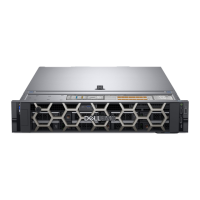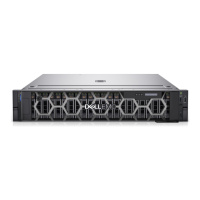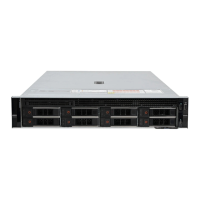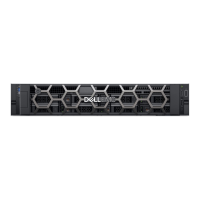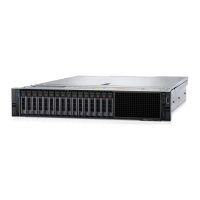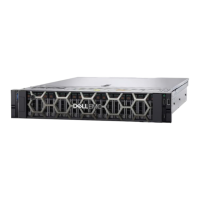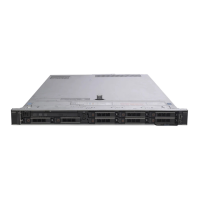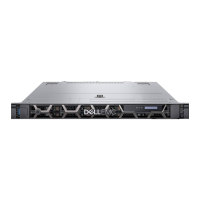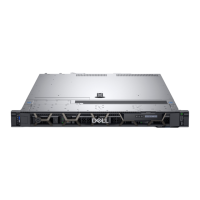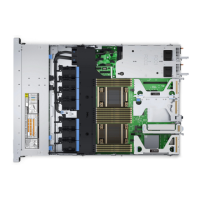Do you have a question about the Dell EMC PowerEdge R730xd and is the answer not in the manual?
Details the various hardware configurations supported by the Dell PowerEdge R730xd.
Identifies and describes the components located on the front panel of the server.
Details the connectors and indicators present on the back panel of the server.
Explains the meaning of diagnostic indicators on the front panel of the system.
Provides instructions on how to find the system's service tag for support.
Lists available documentation and resources for system setup and configuration.
Details the physical dimensions of the Dell PowerEdge R730xd system.
Specifies the maximum weight of the system with all hard drives or SSDs.
Outlines the supported processor types and families for the system.
Lists the types, capacities, and specifications of supported power supply units.
Details the type of system battery supported by the PowerEdge R730xd.
Provides specifications for the PCI Express expansion card risers.
Details supported DIMM types, capacities, and bus frequencies.
Lists supported hard drive and SSD options for various system configurations.
Details the system's USB, NIC, Serial, and VGA port specifications.
Lists supported video resolutions, refresh rates, and color depths.
Outlines temperature, humidity, vibration, shock, and altitude specifications.
Provides step-by-step instructions for setting up the server.
Details how to configure the Integrated Dell Remote Access Controller (iDRAC).
Lists resources and methods for installing the operating system.
Explains methods for downloading system firmware and device drivers.
Provides information on server management software.
Introduces system setup options like BIOS, iDRAC settings, and device configurations.
Details the steps to access and navigate the System Setup utility.
Explains the configuration options available within the System BIOS.
Covers configuring boot modes (BIOS/UEFI) and boot order.
Details how to configure PXE device settings within the UEFI mode.
Describes options for setting system passwords, TPM, and security features.
Details options for viewing and configuring memory settings.
Explains how to view and configure processor-related settings.
Details how to configure SATA device settings and RAID.
Covers viewing and configuring integrated devices like video and USB ports.
Details serial port properties and configuration options.
Explains how to configure system performance and power management settings.
Covers settings like system time, date, and asset tag.
Details how to configure iDRAC parameters using the UEFI utility.
Provides information on system deployment, update, and maintenance capabilities.
Enables selection of boot options and diagnostic utilities.
Provides essential safety guidelines for handling system components.
Outlines prerequisites and steps before performing internal system maintenance.
Details steps to follow after completing internal system maintenance.
Lists the tools required for component removal and installation.
Instructions for removing and installing the optional front bezel.
Provides procedures for removing and installing the system cover.
Diagram illustrating the internal components of the system.
Procedures for removing and installing the system's cooling shroud.
Instructions for removing and installing the hard drive tray.
Procedures for removing and installing individual cooling fans.
Instructions for removing and installing the cooling fan assembly.
Details on supported memory types and installation procedures.
Step-by-step guide for removing memory modules.
Step-by-step guide for installing memory modules.
Procedures for removing and installing processors and heat sinks.
Instructions for removing and installing the PCIe card holder.
Instructions for removing and installing the cable retention bracket.
Instructions for removing and installing the integrated storage controller card.
Details on supported expansion cards and installation guidelines.
Information and procedures for the Internal Dual SD Module.
Instructions for removing and installing the network daughter card.
Instructions for replacing the optional internal USB memory key.
Procedure for replacing the system's real-time clock battery.
Details on supported PSUs and hot spare feature.
Instructions for removing and installing power supply unit blanks.
Instructions for removing and installing AC power supply units.
Details on DC power supply unit wiring and safety ground connections.
Instructions for removing and installing DC power supply units.
Instructions for removing and installing the system board.
Instructions for installing the Trusted Platform Module.
Instructions for removing and installing hard drives and drive blanks.
Procedures for removing and installing hot-swappable hard drives or SSDs.
Instructions for removing and installing hard drive backplanes.
Instructions for replacing the optional SD vFlash media card.
Instructions for removing and installing the vFlash media unit.
Instructions for removing and installing the control panel.
Instructions for removing and installing the I/O panel.
Overview of the ePSA diagnostics for system hardware testing.
Steps to launch diagnostics via the Boot Manager.
Steps to launch diagnostics via the Dell Lifecycle Controller.
Describes the menus and functions within the diagnostic utility.
Explains the function of system board jumpers like PWRD_EN and NVRAM_CLR.
Diagram and list of system board connectors and jumpers.
Procedure to disable system and setup passwords using the password jumper.
Lists the essential components required for the system to complete POST.
Guidance on resolving issues when the system stops responding during startup.
Steps to verify and troubleshoot external device connections.
Steps to diagnose issues with the system's video output.
Steps to troubleshoot problems with USB peripherals.
Steps for troubleshooting USB storage device and system configuration.
Steps for resolving issues with iDRAC Direct laptop connectivity.
Steps to diagnose problems with serial port devices.
Steps to diagnose problems with network interface controllers.
Procedure for handling a system exposed to liquid.
Steps to follow when troubleshooting a physically damaged system.
Steps to diagnose issues related to the system battery.
Guidance for troubleshooting power source and PSU problems.
Steps to diagnose and resolve system cooling issues.
Steps to diagnose and resolve issues with system cooling fans.
Steps to diagnose and resolve system memory issues.
Steps to troubleshoot issues with an internal USB key.
Steps to troubleshoot issues with a micro SD card.
Procedure for troubleshooting issues with hard drives or solid-state drives.
Steps to diagnose and resolve issues with the storage controller.
Steps to diagnose and resolve issues with expansion cards.
Steps to diagnose and resolve issues related to system processors.
Information on warning, diagnostic, and alert messages.
Provides contact information for Dell EMC technical support and sales.
Instructions on how to submit feedback on Dell EMC documentation.
Explains how to use the Quick Resource Locator (QRL) for system information.
Details the various hardware configurations supported by the Dell PowerEdge R730xd.
Identifies and describes the components located on the front panel of the server.
Details the connectors and indicators present on the back panel of the server.
Explains the meaning of diagnostic indicators on the front panel of the system.
Provides instructions on how to find the system's service tag for support.
Lists available documentation and resources for system setup and configuration.
Details the physical dimensions of the Dell PowerEdge R730xd system.
Specifies the maximum weight of the system with all hard drives or SSDs.
Outlines the supported processor types and families for the system.
Lists the types, capacities, and specifications of supported power supply units.
Details the type of system battery supported by the PowerEdge R730xd.
Provides specifications for the PCI Express expansion card risers.
Details supported DIMM types, capacities, and bus frequencies.
Lists supported hard drive and SSD options for various system configurations.
Details the system's USB, NIC, Serial, and VGA port specifications.
Lists supported video resolutions, refresh rates, and color depths.
Outlines temperature, humidity, vibration, shock, and altitude specifications.
Provides step-by-step instructions for setting up the server.
Details how to configure the Integrated Dell Remote Access Controller (iDRAC).
Lists resources and methods for installing the operating system.
Explains methods for downloading system firmware and device drivers.
Provides information on server management software.
Introduces system setup options like BIOS, iDRAC settings, and device configurations.
Details the steps to access and navigate the System Setup utility.
Explains the configuration options available within the System BIOS.
Covers configuring boot modes (BIOS/UEFI) and boot order.
Details how to configure PXE device settings within the UEFI mode.
Describes options for setting system passwords, TPM, and security features.
Details options for viewing and configuring memory settings.
Explains how to view and configure processor-related settings.
Details how to configure SATA device settings and RAID.
Covers viewing and configuring integrated devices like video and USB ports.
Details serial port properties and configuration options.
Explains how to configure system performance and power management settings.
Covers settings like system time, date, and asset tag.
Details how to configure iDRAC parameters using the UEFI utility.
Provides information on system deployment, update, and maintenance capabilities.
Enables selection of boot options and diagnostic utilities.
Provides essential safety guidelines for handling system components.
Outlines prerequisites and steps before performing internal system maintenance.
Details steps to follow after completing internal system maintenance.
Lists the tools required for component removal and installation.
Instructions for removing and installing the optional front bezel.
Provides procedures for removing and installing the system cover.
Diagram illustrating the internal components of the system.
Procedures for removing and installing the system's cooling shroud.
Instructions for removing and installing the hard drive tray.
Procedures for removing and installing individual cooling fans.
Instructions for removing and installing the cooling fan assembly.
Details on supported memory types and installation procedures.
Step-by-step guide for removing memory modules.
Step-by-step guide for installing memory modules.
Procedures for removing and installing processors and heat sinks.
Instructions for removing and installing the PCIe card holder.
Instructions for removing and installing the cable retention bracket.
Instructions for removing and installing the integrated storage controller card.
Details on supported expansion cards and installation guidelines.
Information and procedures for the Internal Dual SD Module.
Instructions for removing and installing the network daughter card.
Instructions for replacing the optional internal USB memory key.
Procedure for replacing the system's real-time clock battery.
Details on supported PSUs and hot spare feature.
Instructions for removing and installing power supply unit blanks.
Instructions for removing and installing AC power supply units.
Details on DC power supply unit wiring and safety ground connections.
Instructions for removing and installing DC power supply units.
Instructions for removing and installing the system board.
Instructions for installing the Trusted Platform Module.
Instructions for removing and installing hard drives and drive blanks.
Procedures for removing and installing hot-swappable hard drives or SSDs.
Instructions for removing and installing hard drive backplanes.
Instructions for replacing the optional SD vFlash media card.
Instructions for removing and installing the vFlash media unit.
Instructions for removing and installing the control panel.
Instructions for removing and installing the I/O panel.
Overview of the ePSA diagnostics for system hardware testing.
Steps to launch diagnostics via the Boot Manager.
Steps to launch diagnostics via the Dell Lifecycle Controller.
Describes the menus and functions within the diagnostic utility.
Explains the function of system board jumpers like PWRD_EN and NVRAM_CLR.
Diagram and list of system board connectors and jumpers.
Procedure to disable system and setup passwords using the password jumper.
Lists the essential components required for the system to complete POST.
Guidance on resolving issues when the system stops responding during startup.
Steps to verify and troubleshoot external device connections.
Steps to diagnose issues with the system's video output.
Steps to troubleshoot problems with USB peripherals.
Steps for troubleshooting USB storage device and system configuration.
Steps for resolving issues with iDRAC Direct laptop connectivity.
Steps to diagnose problems with serial port devices.
Steps to diagnose problems with network interface controllers.
Procedure for handling a system exposed to liquid.
Steps to follow when troubleshooting a physically damaged system.
Steps to diagnose issues related to the system battery.
Guidance for troubleshooting power source and PSU problems.
Steps to diagnose and resolve system cooling issues.
Steps to diagnose and resolve issues with system cooling fans.
Steps to diagnose and resolve system memory issues.
Steps to troubleshoot issues with an internal USB key.
Steps to troubleshoot issues with a micro SD card.
Procedure for troubleshooting issues with hard drives or solid-state drives.
Steps to diagnose and resolve issues with the storage controller.
Steps to diagnose and resolve issues with expansion cards.
Steps to diagnose and resolve issues related to system processors.
Information on warning, diagnostic, and alert messages.
Provides contact information for Dell EMC technical support and sales.
Instructions on how to submit feedback on Dell EMC documentation.
Explains how to use the Quick Resource Locator (QRL) for system information.
| Form Factor | 2U rack server |
|---|---|
| Management | iDRAC8 with Lifecycle Controller |
| Processor | Intel Xeon processor E5-2600 v4 product family; Intel Xeon processor E5-2600 v3 product family |
| RAID Controller | PERC H330, H730, H730P, H830 |
| Power Supply | 495W, 750W, 1100W |
| Expansion Slots | Up to 7 x PCIe 3.0 slots: Up to 3 x full-height, full-length slots; Up to 4 x half-height, half-length slots |
| Operating System Support | Microsoft Windows Server, Red Hat Enterprise Linux, SUSE Linux Enterprise Server, VMware vSphere ESXi |
